(Written by William)
In this Brick Breakdown series I review official LEGO sets, from the perspective of looking at interesting building techniques we can all learn from. Today we will be looking at the #70810 The LEGO Movie MetalBeard’s Sea Cow. You can also check out the previously discussed LEGO techniques found in official LEGO sets at the end of this article. 🙂
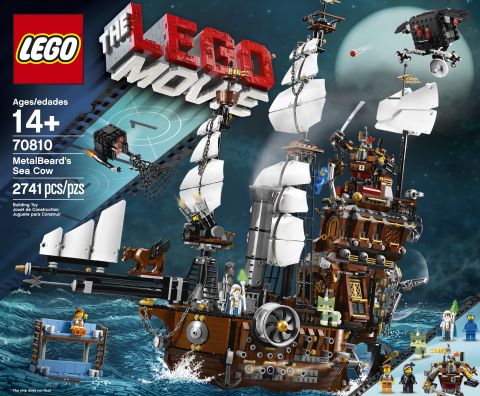
Surprisingly, the LEGO MetalBeard’s Sea Cow is only in a very small portion of The LEGO Movie, so thank goodness LEGO decided to make it into a set. This way we have the full opportunity to enjoy this massive ship, and as a bonus we also get the double-decker couch and two Micro Managers. As far as LEGO ships go, this one is not as long as others from bow to stern, nor it is accurate as a real ship. Rather, much of the emphasis has been placed on the ship’s castle (that’s the raised back section) and unique personality. It’s also neat to see the full compliment of cannons; many times we only get enough for one side of the ship. With all this jam packed coolness, it’s time to check out the techniques used.
➡ ACCENTING WITH LEGO
This is a technique found in nearly every LEGO set you buy, however few cover nearly every inch of a model with as much accenting as you will find in the LEGO MetalBeard’s Sea Cow. Which makes this a great set for discussing the technique as a whole. First, let’s look at functional accenting with LEGO. These are elements that look good as representations of something useful. In this case many of the small cannons covering the sides of the ship. They are simple pin-sleeves in silver to make this vessel look like it’s armed to the teeth. You will typically find this technique used on LEGO beasts as spiny ridges or armored plates. It is considered an accent rather than a function simply because it is only one piece with no real functionality.
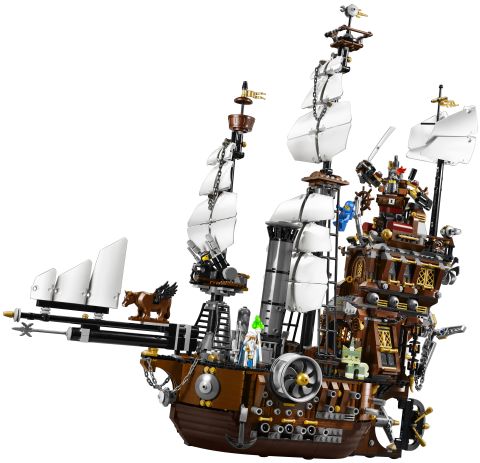
Another accenting technique you can use with LEGO is making patterns. This occurs when you have a series of accent pieces; for instance a dome followed by a bar, followed by a dome, etc., or using alternating colors. This is a great way to make interesting lines and complex looks without straining your creativity, and you can focus on the more difficult building tasks. You can also accent thematically. With all the propellers on the LEGO MetalBeard’s Sea Cow and curly designs with the stickers, the coiled whips provide a thematic crossover for accenting. This not only captures the stylish scrollwork, but you see the twisting motion of a spinning propeller in the design. Other examples of this technique are the crossed wrench and hammer at the back with the gold pirate head – all very thematic touches.
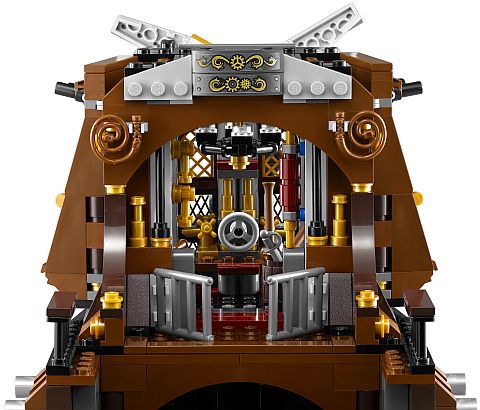
Finally, we can use texturing to accent a LEGO creation. Whether it is a small dish over a large one, a round plate in a smoke-stack, or plates on the side of the ship, this is a good way to bring dimension into a LEGO model. The important factor for this technique is to find something that blends well. Remember, if the pieces look like they belong together the effect will be that much more impressive.
➡ REFRESHING A SIMILAR FRAME
One thing that may catch your eyes is that you build two Micro Managers in the LEGO MetalBeard’s Sea Cow. There is a Micro Manager in pretty much every set designed for The LEGO Movie, however notice that no matter how many times they show up they remain relevant. In contrast think of the LEGO Harry Potter series and how many times you saw Harry in the sets. If you collected the series you were kind of wishing LEGO would put someone else in instead of Harry. With The LEGO Movie Micro Managers that’s not the case. This has to do with the ability to refresh the design while still keeping a recognizable frame. As far as frames go, the one for the Micro Managers is pretty simple; a black box with a slightly funny “face” and some whip-like arms. Every Micro Manager stays true to this basic shape.
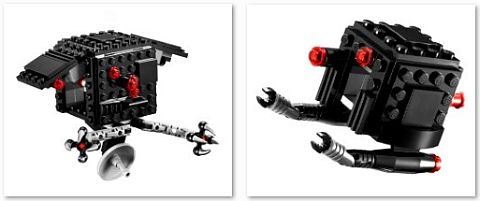
So let’s look at the two Micro Managers in the LEGO MetalBeard’s Sea Cow set to see how LEGO designers were able to keep them similar yet different. First of all, look at the scale: one Micro Manager is larger than the other, which offers even newer opportunities. Next, both of them have their own unique play-element. Finally, they each have distinctly different modes of transport; one floats while the other is propelled by rockets. This LEGO technique comes in handy in all sorts of ways to add variety to your LEGO creations. If you are building a race-track with different racers, you can make each vehicle similar yet unique. Same thing with other vehicles, buildings, brick-built figures, animals, etc.
➡ USING RIGID LEGO SAILS
It’s hard to ignore one of the major features that makes the LEGO MetalBeard’s Sea Cow unlike any other LEGO ship with sails; it has solid plastic sails instead of the cloth variety. Ultimately, this is not entirely unheard of; many of the micro-versions of sailing ships use hard plastic LEGO elements for the sails. What is different is the realization of the trade-offs you have in this decision. Without a doubt, cloth sails will look so much smoother; they flex in all the right ways and imitate the real thing to perfection. They can also be easily printed to make your own sail designs, giving you the freedom not easily achieved with hard plastic pieces. There are even custom printers who will put whatever you want on a cloth element.
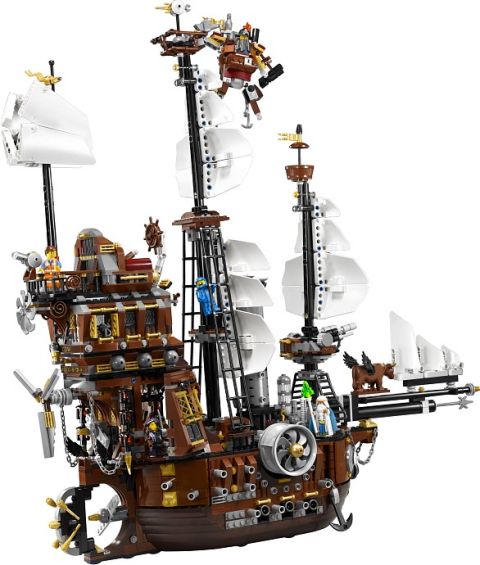
The downside of cloth sails for LEGO ships is that they can get damaged fairly easily; wrinkles, tears, dust-collecting, discoloration, etc. With hard plastic sails you won’t run into most of these problems, and they also give their own unique nature to a LEGO creation. In the case of the LEGO MetalBeard’s Sea Cow they are the logical choice for a steam-punk pirate-ship; giving the ship a tougher, more rigid image that would have been hard to achieve with standard cloth sails. It all comes down to the base material; if you make things out of soft materials, your model will gain that attribute, conversely, a hard material brings an unyielding quality to your design. It is all about using the right stuff for the right look.
➡ RIBBING WITH LEGO
This LEGO technique is buried at the base of the LEGO MetalBeard’s Sea Cow. On the first floor, where all the cannons are, you will build ribbed arches in the front and back of the ship. This was necessary since LEGO designers didn’t want to have pillars, but they needed to build a tall structure. Even real life buildings use this technique in order to hold weight securely; it’s all about giving support in out-of-the-way spaces. For instance, in a tall building if architects would forget to add the floors and internal walls, the building would cave in. Structures are affected by gravity, like everything else. First the load heads down – these are usually your outer edges. Then the weight can fall out or in. If some wall or floor pieces are already installed the building is more likely to wall inward. And this is where ribbing come in. Not only can it push the walls out, but it can catch and hold up any interior weight – if built correctly. It also has the bonus feature of providing lots of space – something pillars can’t offer. The LEGO MetalBeard’s Sea Cow is a beautiful example of this technique.
➡ APPLYING WHAT YOU LEARN
You may not need to go overboard with the quantity of accenting you use like in this set, but the LEGO MetalBeard’s Sea Cow is a great example of all the difference accenting techniques possible with LEGO. At the same time the Micro Managers give us lessons on how to build similar things different ways and freshen up our designs.
The hard sails in this ship are merely an indication that there are different levels of building materials within LEGO. This concept can be expanded into the use of color as well; pastels for example are softer than stark white and black contrast. Also moods can be associated with colors like red hot anger or blue calm. You can even throw in rubbery LEGO elements to further accelerate the look and feel of your LEGO models.
Finally, there’s nothing quite like using a real-world concept in our LEGO models. Having a clear space that holds weight is a good thing to know how to build. Also keep in mind that you don’t have to rely on LEGO making a single piece large enough. With a little ingenuity, you can make your own rib design. This technique is kind of like the wheel; it continues to be around because it just remains a good idea…
So what do you think? How do you like the MetalBeard’s Sea Cow set and the techniques we discussed here? Do you use a lot of accenting for your LEGO creations, or do you keep them simple? How about building variations on the same basic frame? And what do you think of the rigid sails used for the LEGO MetalBeard’s Sea Cow? Do you like them? Have you used a technique like this before? Feel free to share your own experiences, tips or ask questions in the comment section below! 😉
And you might also like to check out the other reviews in this series:
- Brick Breakdown: LEGO MetalBeard’s Duel
- Brick Breakdown: LEGO Minecraft Sets
- Brick Breakdown: LEGO Disney Princess Sets
- Brick Breakdown: LEGO Back to the Future DeLorean
- Brick Breakdown: The LEGO Movie Ice Cream Truck
- Brick Breakdown: LEGO Parisian Restaurant
- Brick Breakdown: The LEGO Movie Flying Flusher
- Brick Breakdown: LEGO The Hobbit Dol Guldur Battle
- Brick Breakdown: LEGO Winter Village Cottage
- Brick Breakdown: LEGO Winter Village Market
- Brick Breakdown: LEGO Lord of the Rings Council of Elrond
- Brick Breakdown: LEGO Castle Dragon Mountain
- Brick Breakdown: LEGO Lord of the Rings Pirate Ship Ambush
- Brick Breakdown: LEGO Ninjago Golden Dragon
- Brick Breakdown: LEGO Superman Black Zero Escape
- Brick Breakdown: LEGO Tower of Orthanc
- Brick Breakdown: LEGO City Dump Truck
- Brick Breakdown: LEGO Monster Fighters Ghost Train
- Brick Breakdown: LEGO Lone Ranger Silver Mine Shootout
- Brick Breakdown: LEGO Lone Ranger Constitution Train Chase
- Brick Breakdown: Ninjago Temple of Light
- Brick Breakdown: LEGO Lone Ranger Colby City Showdown
- Brick Breakdown: LEGO Lone Ranger Comanche Camp
- Brick Breakdown: LEGO Lone Ranger Stagecoach
- Brick Breakdown: LEGO Star Wars AT-RT
- Brick Breakdown: LEGO Arkham Asylum Part 1
- Brick Breakdown: LEGO Arkham Asylum Part 2
- Brick Breakdown: Legends of Chima Polybags


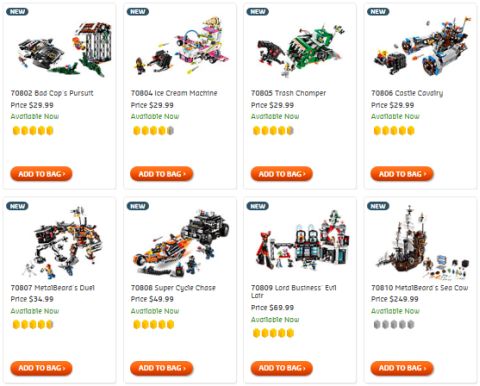










First comment!
Nice review! I only wish I could get this set…….. But, I think I’ll buy a couple smaller ones 😛
Great review! I must say, I don’t accent very much, though I like to make my colors parallel. 😉 I like how all the Micro-managers are the same size, though one w/ the Sea Cow is 6×6 rather than 4×4. I never really thought about the sails, I don’t think it mattered, except that the ship is too large for textiles (is that what its called? 😕 ).
I did like building those arches though. My brothers and I are up to bag 8. 🙂
Oh I forgot to mention, admin, I found a typo. On the last line of the first paragraph under “Accenting,” it says “wit” instead of “with”. 😉
Thanks for cacthing that. Got it fixed. 🙂
I’m getting it on Wednesday! Thanks for the review, I’ll look for these techniques when I build it.
Oh, nice! Let us know how you like it! 😛
Enjoy the build, it is very fun. Although I have to build it w/ my brothers, the complications kinda take the fun out of it… 😕
Also, anyone seen this yet? It’s one of the new Chima sets:
http://brickset.com/sets/70135-1/Cragger-s-Fire-Striker
Yeah, I saw that this morning! Very interesting! 😀
Woah!
yar ye be deactivating of yonder shield
Such an awesome ship, I wish I had money to buy it because it’s on the top of my dream set list
this set is so awesome! just that there are so many cool ones out right now and cool one’s coming in the summer! so I don’t think I’m going to get this set. (unless I win the Emmet awards. 😈 )
Wonderful! Costs ”just” two of my pensions.